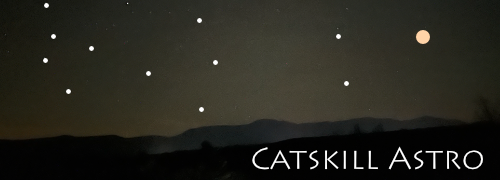Messier Objects
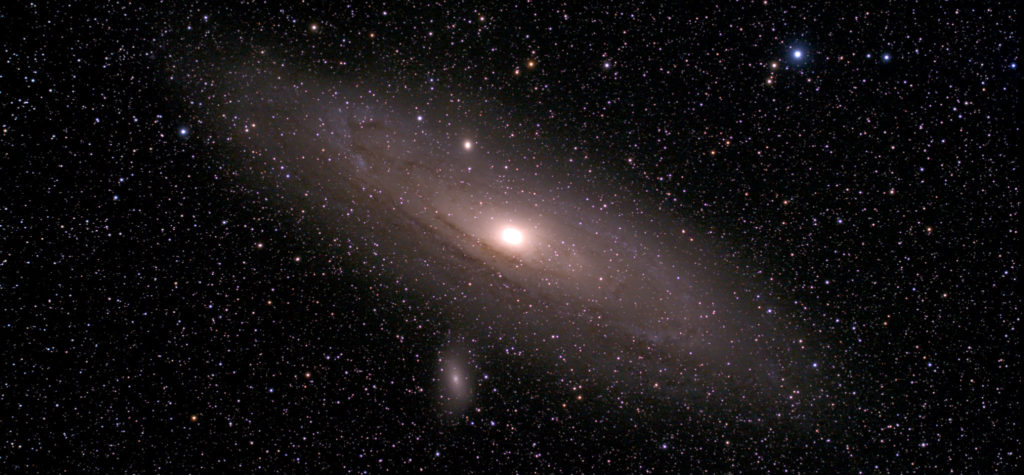
Page 10 of 11
Messier observations 91-100 of 110 total to date.
| Catalog # | Thumbnail | Title/link | Description |
|---|---|---|---|
| M91 | 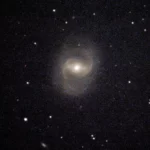 |
M91 / NGC 4548 | The eighth of 9 entries added to the Messier catalog on March 8, 1781, also (#41) credited to Messier. "Nebula without star, in Virgo, above the preceding No. 90: its light is still fainter than that of the above." Following the entry for M91 in the Connoissance des Temps for 1784, Messier added the note below: "Note. The constellation of Virgo, & especially the northern Wing is one of the constellations which encloses the most Nebulae: this Catalog contains thirteen which have been determined: viz. Nos. 49, 58, 59, 60, 61, 84, 85, 86, 87, 88, 89, 90, & 91. All these nebulae appear to be without stars: one can see them only in a very good sky, & near their meridian passage. Most of these nebulae have been pointed to me by M. Méchain.' As pointed out by the editor of [messier.seds.org] this may be the first description of the Virgo cluster of galaxies in the scientific literature. <--> The dimmest target in the Messier catalog, lost for 188 years. Messier had determined its position from M89 while he recorded it was from M58, as the Texas amateur William C. Williams of Fort Worth figured out in 1969 [messier.seds.org] Lovely, barred-spiral galaxy. |
| M92 |  |
M92 / NGC 6341 | The ninth of 9 entries added to the Messier catalog on March 8, 1781. Apparently Messier was not aware that it had been discovered by Johann Elert Bode (discoverer of Bode's Nebula, aka M81) in 1777. "Nebula, fine, distinct, & very bright, between the knee & the left leg of Hercules... It contains no star; the center is clear & brilliant, surrounded by nebulosity & [it] resembles the nucleus of a large Comet: its brightness, its size, approach much that of the nebula which is in the girdle of Hercules. See No. 13 of this Catalog" <--> M92 ranks 8 and 13 respectively for brightness and size. This is a very attractive Globular Cluster with a slightly elongated, brilliant core, surrounded by a halo of blue and red(?) giant stars. It is much less known than M13, which is just a few degrees away. Also, surprising it didn't make the list until so close to the end as it is a naked eye object of apparent magnitude 6.44. Why does it garner so little respect? Perhaps because it rises a little later, and it's a little smaller. |
| M93 |  |
M93 / NGC 2447 / Critter Cluster | Recorded and discovered by Messier (#42) on March 20, 1781, just 12 days after the previous flurry of 9 objects were recorded: "Cluster of small stars, without nebulosity, between the Greater Dog [Canis Major] and the prow of the ship [Puppis of Argo Navis].' (diam 8')" <--> An interesting open cluster on a denser than average star-field, mottled by dark nebulae. Don't see the critter, however. Captured on an unexpected, early morning dark sky along with the final 6 Messier objects. At Dec just shy of -24, this would be a challenging object from my pier. I normally set up my Seestar on my kitchen deck, which is 10 feet higher than the pier, and set back further, giving it a lower horizon . |
| M94 |  |
M94 / Cats Eye Galaxy / NGC 4736 | Recorded the same day as 4 objects, M94-M97, on March 24, 1781, a little over two weeks from the 9-object flurry of March 8: "Nebula without star, above the Heart of Charles [alpha Canum Venaticorum], on the parallel of the star no. 8, of sixth magnitude of the Hunting Dogs [Canes Venatici].... In the center it is brilliant & the nebulosity [is] a bit diffuse. It resembles the nebula which is below Lepus, No. 79; but this one is more beautiful & brighter: M. Méchain has discovered this one on March 22, 1781." (diam. 2.5') <--> Gorgeous spiral galaxy in Canes Vanetici, slightly elongated and pointed evoking an "eye" shape, canted counterclockwise 20° or so. Captured late in the early morning hours. |
| M95 |  |
M95 / NGC 3351 | Recorded the same day as 4 objects, M94-M97, on March 24, 1781, a little over two weeks from the 9-object flurry of March 8: "Nebula without star, above the Heart of Charles [alpha Canum Venaticorum], on the parallel of the star no. 8, of sixth magnitude of the Hunting Dogs [Canes Venatici]...: In the center it is brilliant & the nebulosity [is] a bit diffuse. It resembles the nebula which is below Lepus, No. 79; but this on is more beautiful & brighter: M. Méchain has discovered this one on March 22, 1781." (diam. 2.5') <--> This was a tough observing night because of a bright moon roughly 45° away that reduced contrast. The target was below 40° elevation by the end of the capture. This was my second attempt of the night, but the first (Bin 1) was ravaged by 3 satellite trails, the third about 30 pixels thick. So I switched to Bin 2 to speed things up, and started over. I was anxious to complete a reasonable capture (one way or the other) because it was nearly the end of the observing season for this target and I wasn't sure I'd get another chance this year. In the circumstance, I'm reasonably happy with it. In the gallery, you'll also find a wide-field view taken with my Askar V about a year later. M95 is lower left. M96 and M105 are both visible. See SharpCap annotated view following. |
| M96 | 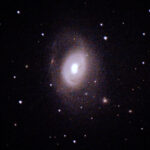 |
M96 / NGC 3368 | Recorded the same day as 4 objects, M94-M97, on March 24, 1781, a little over two weeks from the 9-object flurry of March 8: "Nebula without star, in the Lion [Leo], near the preceding [No. 95]: this one is less distinct, both are on the same parallel of Regulus: they resemble the two nebulae in the Virgin [Virgo], Nos. 84 and 86. M. Méchain saw them both on March 20, 1781." <--> Seeing was improving, but still proved challenging on this relatively faint galaxy. |
| M97 | 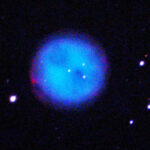 |
M97 / Owl Nebula / NGC 3587 | Recorded the same day as 4 objects, M94-M97, on March 24, 1781, a little over two weeks from the 9-object flurry of March 8: "Nebula in the great Bear [Ursa Major], near Beta: It is difficult to see, reports M. Méchain, especially when one illuminates the micrometer wires: its light is faint, without a star. M. Méchain saw it the first time on Feb 16, 1781, & the position is that given by him. Near this nebula he has seen another one, [the position of] which has not yet been determined [M108], and also a third which is near Gamma of the Great Bear [M109 near Gamma Ursae Majoris]." <--> There are actually two observations of M97 depicted here. Described in this text is my first, which you'll see in the gallery but is not the featured image. Note M108 towards the bottom of the image. The featured image is based on another observation a few weeks later, this time captured with my EdgeHD 8" and ASI294 camera. A lot more focal length (2,032 v 250mm) and a better capture in some respects, but I'm fond of the Seestar 50 image because it shows M97 in context with M108. |
| M98 |  |
M98 / NGC 4192 | After a break of 3 weeks, three Méchain galaxies (M98-M100) recorded April 13, 1781: "Nebula without star, of an extremely faint light, above the northern wing of the Virgin [Virgo], on the parallel & close to the star no. 6, fifth magnitude, of the hair of Berenice [Coma Berenices].... M. Méchain saw it on Mar 15, 1781." <--> This is a not quite edge-on view of a spiral galaxy. The outer band is surprisingly challenging to image using EAA techniques. Managed to sneak in this capture at the beginning of galaxy season using my mono rig, which is much more sensitive than the OSC. In the gallery you'll see an earlier attempt with the 294 camera, heavily processed, from May, 2024. |
| M99 | 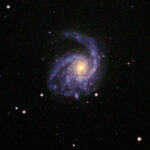 |
M99 / NGC 4254 | After a break of 3 weeks, three Méchain galaxies (M98-M100) recorded April 13, 1781: "Nebula without star, of an extremely faint light, above the northern wing of the Virgin [Virgo], on the parallel & close to the star no. 6, fifth magnitude, of the hair of Berenice [Coma Berenices].... M. Méchain saw it on Mar 15, 1781." <--> Surprisingly challenging galaxy. The core is quite bright, but the surface brightness of the arms is low, and the interesting bits are in the extended arms and the dust lanes that surround the galaxy. This galaxy was presumably a symmetrical spiral at origin, and has been disrupted by gravitational forces as it entered the Virgo galaxy cluster (which extends to Coma). |
| M100 | 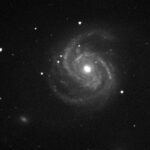 |
M100 / NGC 4321 / Mirror Galaxy | After a break of 3 weeks, three Méchain galaxies (M98-M100) recorded April 13, 1781: "Nebula without star, of the same light as the preceding [M99], situated in the ear of Virgo. Seen by M. Méchain on March 15, 1781. These three nebulae, nos. 98, 99 & 100, are very difficult to recognize, because of the faintness of their light: one can observe them only in good weather, & near their passage of the Meridian." <--> This is one of the prettiest spiral galaxies in the Messier catalog: almost like a cross of M101 and the Fireworks Galaxy. This was a re-visit to this object using my standard mono galaxy rig, which is much faster than any of my OSC options. I was intrigued by what appears to be interaction between M100 and NGC 4323. I thought I saw some sort of tidal flow between them, and the inverted image makes it clear that there is. M100 is itself a gorgeous intermediate spiral galaxy, just suggesting the beginning of a bar. I was hoping to integrate about 40 minutes, but thick clouds rolled in eventually. The last 15m of integration took more than an hour as SharpCap's brightness filter cut out most lights. |
